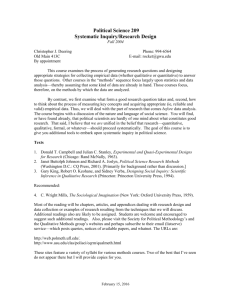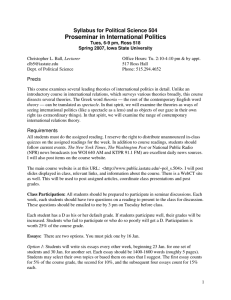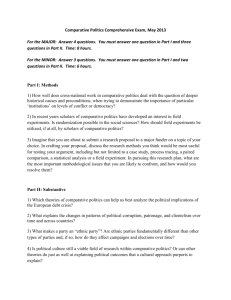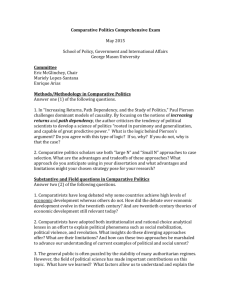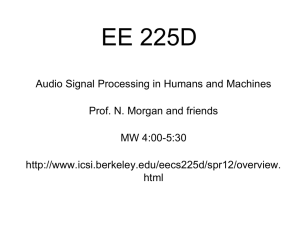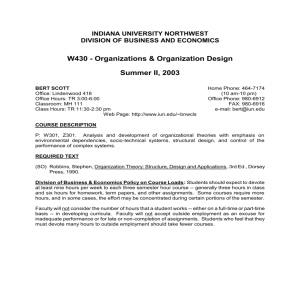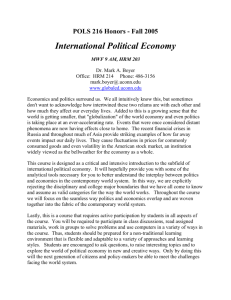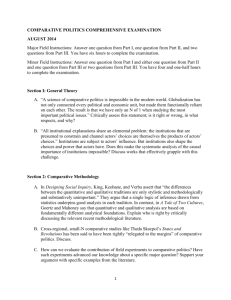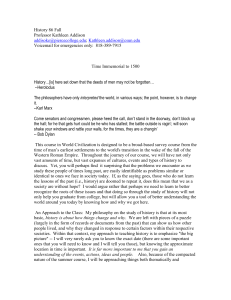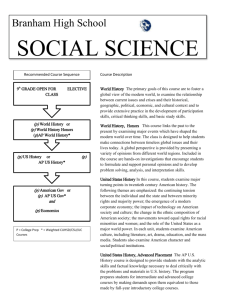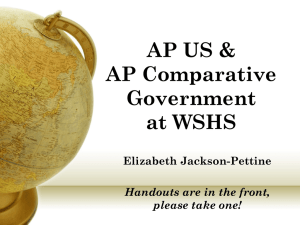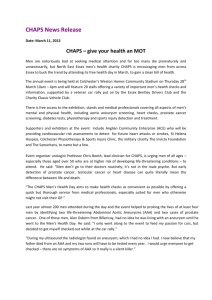SyllabusFall 2005
advertisement
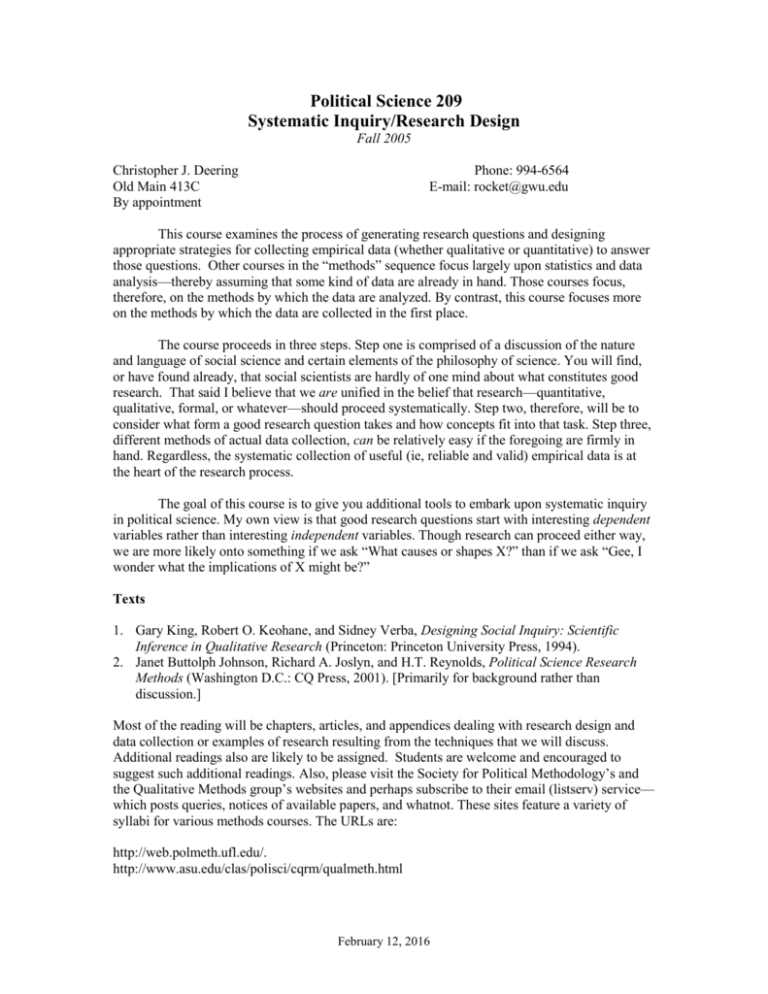
Political Science 209 Systematic Inquiry/Research Design Fall 2005 Christopher J. Deering Old Main 413C By appointment Phone: 994-6564 E-mail: rocket@gwu.edu This course examines the process of generating research questions and designing appropriate strategies for collecting empirical data (whether qualitative or quantitative) to answer those questions. Other courses in the “methods” sequence focus largely upon statistics and data analysis—thereby assuming that some kind of data are already in hand. Those courses focus, therefore, on the methods by which the data are analyzed. By contrast, this course focuses more on the methods by which the data are collected in the first place. The course proceeds in three steps. Step one is comprised of a discussion of the nature and language of social science and certain elements of the philosophy of science. You will find, or have found already, that social scientists are hardly of one mind about what constitutes good research. That said I believe that we are unified in the belief that research—quantitative, qualitative, formal, or whatever—should proceed systematically. Step two, therefore, will be to consider what form a good research question takes and how concepts fit into that task. Step three, different methods of actual data collection, can be relatively easy if the foregoing are firmly in hand. Regardless, the systematic collection of useful (ie, reliable and valid) empirical data is at the heart of the research process. The goal of this course is to give you additional tools to embark upon systematic inquiry in political science. My own view is that good research questions start with interesting dependent variables rather than interesting independent variables. Though research can proceed either way, we are more likely onto something if we ask “What causes or shapes X?” than if we ask “Gee, I wonder what the implications of X might be?” Texts 1. Gary King, Robert O. Keohane, and Sidney Verba, Designing Social Inquiry: Scientific Inference in Qualitative Research (Princeton: Princeton University Press, 1994). 2. Janet Buttolph Johnson, Richard A. Joslyn, and H.T. Reynolds, Political Science Research Methods (Washington D.C.: CQ Press, 2001). [Primarily for background rather than discussion.] Most of the reading will be chapters, articles, and appendices dealing with research design and data collection or examples of research resulting from the techniques that we will discuss. Additional readings also are likely to be assigned. Students are welcome and encouraged to suggest such additional readings. Also, please visit the Society for Political Methodology’s and the Qualitative Methods group’s websites and perhaps subscribe to their email (listserv) service— which posts queries, notices of available papers, and whatnot. These sites feature a variety of syllabi for various methods courses. The URLs are: http://web.polmeth.ufl.edu/. http://www.asu.edu/clas/polisci/cqrm/qualmeth.html February 12, 2016 Course Requirements The fundamental requirement for this course is a careful reading of the assigned material leading to informed discussion each week. No student can do well in this course without effective oral participation. This should not be confused with loud, frequent, or extended participation. Throughout the course there will be several smallish assignments. The major product for the course, however, will be to design and present to the class a proposed piece of research. This will be formally presented but need not (should not?) be too broad in scope. The research must be based in an existing literature, contain formally stated hypotheses, and include a plan for executing the research (concept identification, measurement, and data collection method). In order to provide early feedback to the student, this may be undertaken in an iterative fashion. Course evaluations are, therefore, based upon class participation, the written work, and a final exam. Course Schedule and Reading Assignments 1. Sept 1 Communicating in Political Science Assignment: Please bring in one article, not from APSR and not from International Security from a major, peer-reviewed, journal in your subfield. Johnson, Joslyn and Reynolds, Chaps. 1 and 2. King, Keohane, and Verba, Chap. 1. American Political Science Association, Style Manual for Political Science (Washington, DC: APSA, 2001). Teresa Pelton Johnson, “Writing for International Security: A Contributors' Guide.”International Security. 16 (Autumn, 1991): 171-180. Betty H. Zisk, “The Compleat Jargoner: How to Obfuscate the Obvious Without Half Trying.” The Western Political Quarterly 23(March 1970): 55-56. Barry Weingast, “Structuring Your Papers (Caltech Rules).” http://www.stanford.edu/~weingast/caltech_rules.html “Deering’s Diet: A Dissertation Proposal Budget” (Class Handout) 2. Sept 8 The Idea of a Social Science I The Growth of Scientific Knowledge: Popper, Kuhn, Lakatos Here are the originals more or less, recall that I’ve provided a section from Foundations of Philosophy of Science, Fetzer, with enough of each to get you by. Karl Popper, The Logic of Scientific Discovery [1934] (Basic Books, 1959), Chaps. 1 and 4. Thomas S. Kuhn, The Structure of Scientific Revolutions (Chicago: University of Chicago. 1962. Imre Lakatos, “Falsification and the Methodology of Scientific Research Programmes,” from Lakatos, et. al., Criticism and the Growth of Knowledge (Cambridge: Cambridge University Press, 1970). Online at the following url: http://www.philosophy.ru/edu/ref/sci/lakatos.html Also please read: Alasdair MacIntyre, “The Idea of a Social Science,” in Ryan, The Philosophy of Social Explanation (Oxford, 1973): 15-32. Peter Winch, “The Idea of a Social Science,” [excerpts from the book] from February 12, 2016 Bredo and Feinberg, Knowledge and Values in Social and Educational Research (Temple, 1972). 3. Sep. 15 The Idea of a Social Science II J. B. Bury, The Idea of Progress: An Inquiry Into Its Origin and Growth (London: Macmillan and Co., 1928), “Introduction.” E.H. Carr, What Is History? (New York: Knopf, 1962), Chaps. 3-4. Paul Pierson, Politics in Time: History, Institutions, and Social Analysis (Princeton University Press, 2004), Chaps 1 and Conclusion (6). Also recommended: Alfred W. Crosby, The Measure of Reality: Quantification and Western Society, 1250-1600 (Cambridge: Cambridge University Press, 1997). 4. Oct 6 Concepts and Measurement Part I of paper due – problem introduction, dependent variable, and literature niche. Johnson, Joslyn, and Reynolds, Chap. 4. King, Keohane, and Verba, Chap. 5. Maurice Mandelbaum, “Societal Facts.” In Ryan, The Philosophy of Social Explanation. (Oxford University Press, 1973): 105-118. Arthur L. Kalleberg, “Concept Formation in Normative and Empirical Studies: Toward Reconciliation in Political Theory.” American Political Science Review. 63 (March 1969): 26-39. Selltiz, Wrightsman, and Cook, “General Problems of Measurement,” Research Methods in Social Relations (Holt, Rinehart, and Winston). Robert Adcock and David Collier, “Measurement Validity: A Shared Standard for Qualitative and Quantitative Research.” American Political Science Review. 95 (September 2001): 529-546 David Collier; James E. Mahon, Jr., “Conceptual "Stretching" Revisited: Adapting Categories in Comparative Analysis,” The American Political Science Review.Vol. 87, No. 4 (Dec., 1993): 845-855 5. Oct. 13 Hypotheses and Counterfactuals Assignment Submit 2 or 3 news-based hypotheses by Wednesday. Johnson, Joslyn and Reynolds, Chaps. 3 and 5. King, Keohane, and Verba, Chap. 2. James D. Fearon, “Counterfactuals and Hypothesis Testing in Political Science.” World Politics. 43 (January 1991): 169-195. 6. Oct. 20 Theories, Models, and Paradigms Charles A. Lave and James G. March, An Introduction to Models in the Social Sciences (New York: Harper & Row, 1975), Chaps. 1-3. Morris P. Fiorina, “Formal Models of Political Science.” American Journal of Political Science 19 (February 1975): 133-159. February 12, 2016 Albert O. Hirschman, “The Search for Paradigms as a Hindrance to Understanding.” World Politics 22 (April 1970): 329-343. Graham T. Allison, Essence of Decision: Explaining the Cuban Missile Crisis (Boston: Little, Brown, 1971): 1-9, 245-263. 7. Oct. 27 Causality, Inference, and Interpretation Campbell and Stanley, pp. 1-6 King, Keohane, and Verba, Chap. 3. Herbert M. Kritzer, “The Data Puzzle: The Nature of Interpretation in Quantitative Research,” American Journal of Political Science 40 (February 1996): 1-32. Read Chapter 10 on Process Tracing in Alexander L. George and Andrew Bennett, Case Studies and Theory Development in the Social Sciences. Cambridge, Massachusetts. MIT Press. 2005. 8. Nov 3 Experimental and Quasi-Experimental Designs Johnson, Joslyn and Reynolds, Chap. 5. Campbell and Stanley, pp. 6-76. Albert D. Cover and Bruce S. Brumberg, “Baby Books and Ballots: The Impact of Congressional Mail on Constituent Opinion.” American Political Science Review. 76 (June 1982): 347-359. Other experiments as selected. 9. Nov. 10 Comparative Methods, Case Studies and Case Selection I King, Keohane, and Verba, Chaps. 4 and 6. Arthur L. Kalleberg, “The Logic of Comparison: A Methodological Note on the Comparative Study of Political Systems.” World Politics. 19 (October 1966): 6982. Arend Lijphart, “Comparative Politics and the Comparative Method.” American Political Science Review 65 (September 1971): 682-693. Chapter 8 in Alexander L. George and Andrew Bennett, Case Studies and Theory Development in the Social Sciences. Cambridge, Massachusetts. MIT Press. 2005. Douglas Dion, “Evidence and Inference in the Comparative Case Study.” Comparative Politics, 30 (January 1998): 127-145. Collier and Mahoney, “Insights and Pitfalls: Selection Bias in Qualitative Research,” World Politics 49 (Oct. 1996): 56-91. OR Collier, Mahoney, and Searight, “Claiming Too Much: Warnings About Selection Bias,” in Brady and Collier, Rethinking Social Inquiry. Rowman & Littlefield, 2004. Recommended for IR types: Achen and Snidal, “Rational Deterrence Theory and Comparative Case Studies,” 41 World Politics (Jan. 1989): 143-169. February 12, 2016 10. Nov. 17 Survey Designs and Elite Interviewing Field Studies and Participant Observation Johnson, Joslyn and Reynolds, Chaps. 7, 8 and 10. Joel D. Aberbach, James D. Chaney, and Bert A. Rockman, “Exploring Elite Attitudes: Some Methodological Issues,” 2 Political Methodology (1975): 1-27. Richard Fenno, “US House Members in Their Constituencies: An Exploration.” American Political Science Review. 71 (Sept. 1977): 883917. Also, read the Appendix to his book, Home Style. Cynthia McClintock, Peasant Cooperatives and Political Change in Peru (Princeton, 1981): Introduction, Chap. 4, Appendixes. Recommended (highly) if you’re actually going to write one: Selltiz, Wrightsman and Cook, Appendix B, “Questionnaire Construction and Interview Prodedures,” pp. 541-573. Earl Babbie, “Conceptualization and Instrument Design,” Survey Research Methods (Belmont, Ca: Wadsworth, 1973). 11. Dec. 1 Presentation and Discussion of Research Designs 12. Dec. 8 Presentation and Discussion of Research Designs 13. Dec. 12 Presentation and Discussion of Research Designs February 12, 2016
